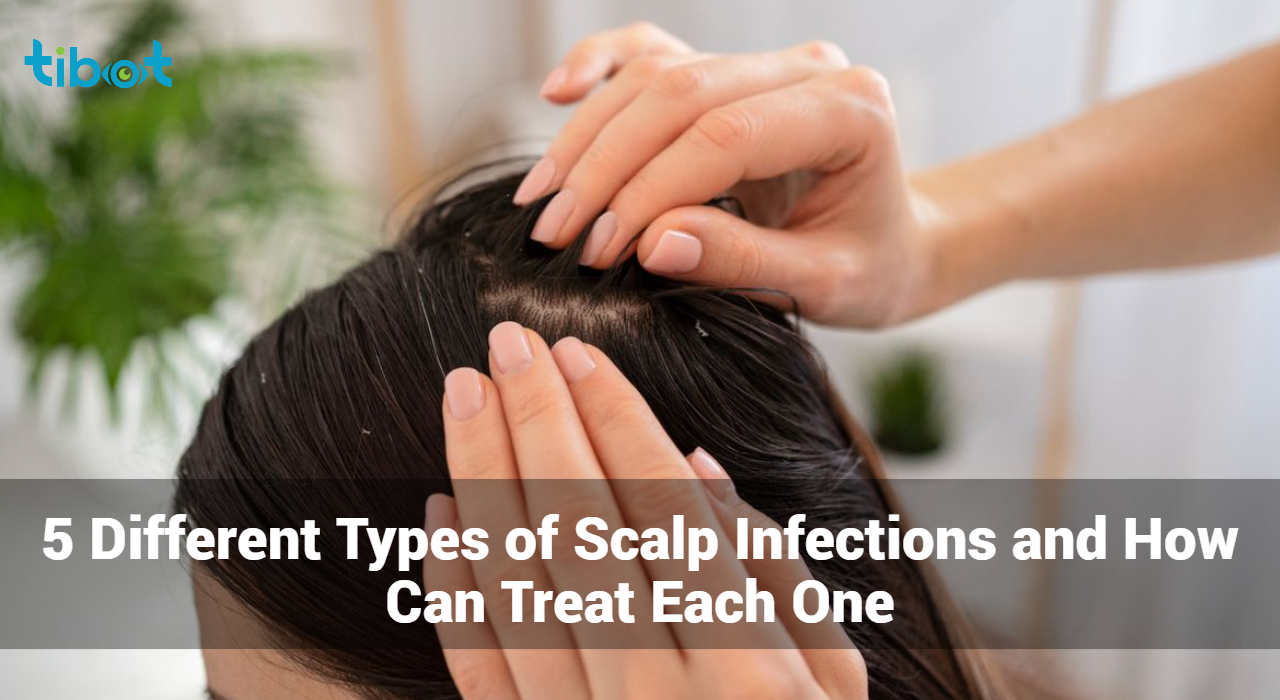5 Different Types of Scalp Infections and How Can Treat Each One

Scalp infections can be a distressing condition, affecting the health and appearance of your hair and skin. Various types of scalp infections exist, each caused by different pathogens and requiring specific treatments. This comprehensive guide aims to provide detailed information on the different types of scalp infections, their causes, symptoms, and effective treatments. Understanding these aspects will help you manage and prevent scalp infections more effectively.
What Are Scalp Infections?
Scalp infections are conditions that affect the skin and hair follicles of the scalp, resulting from the invasion of pathogenic organisms such as fungi, bacteria, viruses, and parasites. These infections can cause a range of symptoms, including itching, redness, scaling, and hair loss, and can affect people of all ages.
Most Common 5 Different Types of Scalp Infections
1. Fungal Infections
a. Tinea Capitis (Ringworm of the Scalp)
Cause:
- Caused by dermatophyte fungi, such as Trichophyton and Microsporum species.
Symptoms:
- Circular, scaly patches on the scalp
- Hair loss in the affected areas
- Itching and redness
- Black dots on the scalp where hair has broken off
Treatment:
- Antifungal medications: Oral antifungal drugs like griseofulvin or terbinafine are commonly prescribed.
- Topical antifungal shampoos: Ketoconazole or selenium sulfide shampoos can help reduce fungal load.
- Good hygiene practices: Regular washing and avoiding sharing personal items.
b. Seborrheic Dermatitis
Cause:
- Linked to an overgrowth of Malassezia yeast, which thrives on oily areas of the skin.
Symptoms:
- Red, greasy, and scaly patches on the scalp
- Dandruff or flaking skin
- Itching and inflammation
Treatment:
- Antifungal shampoos: Shampoos containing ketoconazole, selenium sulfide, or zinc pyrithione.
- Topical corticosteroids: To reduce inflammation and itching.
- Regular washing: Helps control the overgrowth of yeast.
2. Bacterial Infections
a. Folliculitis
Cause:
- Often caused by Staphylococcus aureus bacteria infecting hair follicles.
Symptoms:
- Red, inflamed bumps or pustules around hair follicles
- Itching and tenderness
- Possible pus drainage from the bumps
Treatment:
- Topical antibiotics: Mupirocin or clindamycin ointments.
- Oral antibiotics: In severe cases, oral antibiotics like dicloxacillin or cephalexin may be needed.
- Good hygiene: Regular washing and avoiding tight headgear.
b. Impetigo
Cause:
- Usually caused by Staphylococcus aureus or Streptococcus pyogenes bacteria.
Symptoms:
- Red sores or blisters that rupture, ooze, and form a yellow-brown crust
- Itching and tenderness
- Often spreads through scratching or contact
Treatment:
- Topical antibiotics: Mupirocin or fusidic acid creams.
- Oral antibiotics: For more extensive infections, oral antibiotics like flucloxacillin.
- Good hygiene: Regular cleaning of affected areas and avoiding scratching.
3. Viral Infections
Herpes Zoster (Shingles)
Cause:
- Reactivation of the varicella-zoster virus, which causes chickenpox.
Symptoms:
- Painful, blistering rash on one side of the scalp
- Tingling or burning sensation before the rash appears
- Flu-like symptoms (fever, headache)
Treatment:
- Antiviral medications: Acyclovir, valacyclovir, or famciclovir to reduce the severity and duration of the infection.
- Pain relief: Analgesics or corticosteroids for severe pain.
- Good hygiene: Keeping the rash clean and dry to prevent secondary bacterial infection.
4. Parasitic Infections
Head Lice (Pediculosis Capitis)
Cause:
- Infestation by Pediculus humanus capitis, a parasitic insect.
Symptoms:
- Intense itching, especially behind the ears and on the neck
- Visible nits (lice eggs) attached to hair shafts
- Crawling sensation on the scalp
Treatment:
- Over-the-counter lice treatments: Permethrin or pyrethrin shampoos.
- Prescription treatments: Malathion lotion or oral ivermectin for resistant cases.
- Combing: Using a fine-toothed comb to remove nits and lice.
- Cleaning personal items: Washing bedding, hats, and clothing in hot water.
5. Inflammatory Conditions
Psoriasis
Cause:
- Autoimmune disorder leading to rapid skin cell turnover.
Symptoms:
- Red, thickened patches with silvery scales
- Itching and discomfort
- Cracking and bleeding in severe cases
Treatment:
- Topical treatments: Corticosteroids, vitamin D analogs, or salicylic acid.
- Phototherapy: Ultraviolet light therapy to reduce inflammation and slow cell turnover.
- Systemic medications: Methotrexate, cyclosporine, or biologics for severe cases.
What Causes of Scalp Infections?
Scalp infections can be caused by various pathogens, including fungi, bacteria, viruses, and parasites. Understanding the specific cause is crucial for effective treatment. Here are some common causes:
Poor Hygiene
- Infrequent Washing: Allows buildup of oils, dirt, and sweat, creating an environment for pathogens.
- Improper Cleaning Techniques: Not thoroughly cleaning the scalp and hair can leave residues that promote infections.
Environmental Factors
- Humidity and Heat: Create favorable conditions for fungal and bacterial growth.
- Cold Weather: Can exacerbate conditions like seborrheic dermatitis and psoriasis.
Individual Health Factors
- Weakened Immune System: Conditions such as diabetes, HIV/AIDS, or treatments like chemotherapy can reduce the body’s ability to fight infections.
- Underlying Skin Conditions: Eczema, dermatitis, and other skin conditions can compromise the scalp’s barrier function, making it more susceptible to infections.
What Are The Symptoms of Scalp Infections?
Symptoms of scalp infections can vary depending on the type of infection but generally include:
- Redness and inflammation
- Itching or burning sensation
- Hair loss or thinning
- Scaling or flaking skin
- Pain or tenderness
- Pustules, blisters, or sores
- Crusting or oozing
How Can You Treatments for Scalp Infections?
General Treatment Guidelines
- Identify the cause: Accurate diagnosis by a healthcare professional is essential for effective treatment.
- Maintain hygiene: Regular washing with appropriate shampoos and keeping the scalp clean.
- Avoid irritants: Minimize exposure to harsh chemicals and excessive heat.
- Follow prescribed treatments: Complete the full course of any prescribed medication to prevent recurrence.
Specific Treatments For Fungal Infections
- Oral antifungals: Griseofulvin, terbinafine, or itraconazole.
- Topical antifungals: Ketoconazole, ciclopirox, or selenium sulfide shampoos.
- Good hygiene practices: Regular washing, avoiding sharing personal items.
Specific Treatments For Bacterial Infections
- Topical antibiotics: Mupirocin, fusidic acid.
- Oral antibiotics: Dicloxacillin, cephalexin.
- Good hygiene: Regular cleaning, avoiding tight headgear.
Specific Treatments For Viral Infections
- Antiviral medications: Acyclovir, valacyclovir, famciclovir.
- Pain relief: Analgesics or corticosteroids.
- Good hygiene: Keeping the rash clean and dry.
Specific Treatments For Parasitic Infections
- Over-the-counter lice treatments: Permethrin, pyrethrin.
- Prescription treatments: Malathion lotion, oral ivermectin.
- Combing: Fine-toothed comb to remove nits and lice.
- Cleaning personal items: Washing in hot water.
Specific Treatments For Inflammatory Conditions
- Topical treatments: Corticosteroids, vitamin D analogs, salicylic acid.
- Phototherapy: Ultraviolet light therapy.
- Systemic medications: Methotrexate, cyclosporine, biologics.
What Are The Prevention Options of Scalp Infections?
Preventing scalp infections involves maintaining good hygiene and taking specific precautions:
- Regular washing: Use mild shampoos and avoid over-washing.
- Avoid sharing personal items: Combs, brushes, hats, and towels.
- Protect the scalp: Wear a hat or use sunscreen to prevent sunburn.
- Keep the scalp dry: After sweating or washing, thoroughly dry the scalp.
- Manage underlying conditions: Control conditions like diabetes that can predispose to infections.
- Prompt treatment: Seek medical advice at the first sign of infection to prevent spread and complications.
Analyze Skin Diseases
Use our AI chatbot to determine your skin condition
Home Remedies for Scalp Infections
Scalp infections can be uncomfortable and embarrassing, but several home remedies can help alleviate symptoms and promote healing. While these remedies can be effective for mild infections, it’s important to seek medical advice for more severe cases or if symptoms persist. Here are some natural treatments you can try at home:
1. Tea Tree Oil
Properties:
- Antifungal, antibacterial, and anti-inflammatory.
How to Use:
- Mix a few drops of tea tree oil with a carrier oil (like coconut or olive oil).
- Massage the mixture into your scalp and leave it on for 30 minutes to an hour before washing it out with a mild shampoo.
- Repeat 2-3 times a week.
2. Apple Cider Vinegar
Properties:
- Antimicrobial and anti-inflammatory.
How to Use:
- Dilute equal parts of apple cider vinegar with water.
- Apply the solution to your scalp using a cotton ball or spray bottle.
- Leave it on for 15-20 minutes before rinsing with lukewarm water.
- Use 2-3 times a week.
3. Aloe Vera
Properties:
- Soothing, anti-inflammatory, and antimicrobial.
How to Use:
- Extract fresh aloe vera gel from a leaf or use store-bought pure aloe vera gel.
- Apply the gel directly to your scalp and leave it on for 30 minutes.
- Rinse with lukewarm water and a mild shampoo.
- Use 2-3 times a week.
4. Coconut Oil
Properties:
- Antimicrobial and moisturizing.
How to Use:
- Warm a small amount of coconut oil until it becomes liquid.
- Massage the oil into your scalp and leave it on for at least 30 minutes, or overnight for best results.
- Wash your hair with a mild shampoo.
- Repeat 2-3 times a week.
5. Neem Oil
Properties:
- Antifungal, antibacterial, and anti-inflammatory.
How to Use:
- Mix a few drops of neem oil with a carrier oil (like coconut or olive oil).
- Massage the mixture into your scalp and leave it on for 30 minutes to an hour.
- Wash with a mild shampoo.
- Use 2-3 times a week.
6. Baking Soda
Properties:
- Antifungal and helps to balance pH levels.
How to Use:
- Mix 2 tablespoons of baking soda with water to form a paste.
- Apply the paste to your scalp and leave it on for 10-15 minutes.
- Rinse thoroughly with lukewarm water.
- Use once a week.
7. Garlic
Properties:
- Antimicrobial and antifungal.
How to Use:
- Crush a few garlic cloves to extract the juice.
- Mix the juice with honey or coconut oil to reduce its strong smell and potential skin irritation.
- Apply the mixture to your scalp and leave it on for 15-20 minutes.
- Rinse thoroughly with a mild shampoo.
- Use once a week.
8. Onion Juice
Properties:
- Antimicrobial and promotes hair growth.
How to Use:
- Extract juice from a fresh onion.
- Apply the juice to your scalp and leave it on for 30 minutes.
- Rinse with a mild shampoo.
- Use 1-2 times a week.
9. Yogurt and Honey Mask
Properties:
- Antimicrobial, soothing, and moisturizing.
How to Use:
- Mix equal parts of plain yogurt and honey.
- Apply the mixture to your scalp and hair.
- Leave it on for 30 minutes before rinsing with lukewarm water.
- Use 1-2 times a week.
10. Jojoba Oil
Properties:
- Antimicrobial and closely resembles the natural oils of the scalp.
How to Use:
- Warm a small amount of jojoba oil.
- Massage it into your scalp and leave it on for at least 30 minutes or overnight.
- Wash with a mild shampoo.
- Use 2-3 times a week.
Important Tips
- Patch Test: Always perform a patch test before using any new remedy to ensure you do not have an allergic reaction.
- Hygiene: Maintain good scalp hygiene by washing your hair regularly with a mild shampoo.
- Avoid Sharing: Do not share personal items like combs, brushes, hats, or pillows to prevent the spread of infections.
- Diet: Eat a balanced diet rich in vitamins and minerals to support overall scalp health.
- Hydration: Drink plenty of water to keep your scalp hydrated.
When to Seek Medical Help?
While home remedies can be effective for mild infections, it’s important to consult a healthcare professional if you experience:
- Severe pain or discomfort.
- Persistent symptoms despite home treatment.
- Signs of a severe infection such as pus, fever, or spreading redness.
- Significant hair loss.
By using these home remedies and maintaining good scalp hygiene, you can help manage and prevent scalp infections. Always consult with a healthcare provider for persistent or severe infections to ensure proper treatment and care.
Conclusion
Scalp infections are common but manageable with proper diagnosis and treatment. Understanding the different types of scalp infections, their causes, symptoms, and treatments can help you maintain a healthy scalp and prevent future infections. Always consult a dermatologist for an accurate diagnosis and personalized treatment plan.





